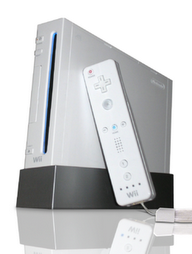Hardware
Hardware
The Wii console is Nintendo's smallest home unit to date; it measures 44 mm (1.73 in) wide, 157 mm (6.18 in) tall, and 215.4 mm (8.48 in) deep in its vertical orientation, the near-equivalent of three DVD cases stacked together. The included stand measures 55.4 mm (2.18 in) wide, 44 mm (1.73 in) tall, and 225.6 mm (8.88 in) deep, The system weighs 1.2 kg , which makes it the lightest of the three major seventh generation consoles. The console can be placed either horizontally or vertically. The prefix for the numbering scheme of the system and its parts and accessories is "RVL-" after its project code name of "Revolution".
The front of the console features an illuminated slot-loading optical media drive that accepts both 12 cm Wii Optical Discs and Nintendo GameCube Game Discs. The blue light in the disc slot illuminates briefly when the console is turned on, and pulsates when new data is received through WiiConnect24. When there is no WiiConnect24 information, the light is off. The disc slot light remains off during game play or when using other features. Two USB ports are located at its rear, and an SD card slot hides behind the cover on the front of the console. The SD card can be used for uploading photos as well as backing up saved game data and downloaded Virtual Console games. As a presently un-circumvented system of digital rights management, Virtual Console data cannot be restored to any system except the unit of origin. To use the SD slot for game save transferring, a software update must be downloaded, so a system that has not been connected to the Internet cannot utilize this feature. The SD card can also be used to create customized in-game music from stored MP3 files, as shown in Excite Truck.
Nintendo has shown the console and the Wii Remote in white, black, silver, lime green, and red, but has initially been available only in white. At E3 2006, the Wii Remote was shown in light blue. Shigeru Miyamoto stated that other colors would be available after the easing of supply limitations, which were stated to continue until (northern) Spring.Numerous minor changes were made to the design between its original unveiling and launch, including the Nintendo branding used and button placements.
The Wii launch package includes the console, a stand to allow the console to be placed vertically, a circular clear stabilizer for the main stand, one Wii Remote, one Nunchuk attachment, one Sensor Bar, a removable stand for the bar, one external main power adapter, two AA batteries, one composite AV cable with RCA connectors (component video and other types of cables are available separately), operation documentation, and (in all regions excluding Japan) a copy of Wii Sports.
A Nintendo spokesperson has announced that the company plans to release a version of the console with DVD-Video playback capabilities in 2007.
Even though software will be used to enable DVD-Video functionality, it "requires more than a firmware upgrade" and cannot therefore be implemented through the WiiConnect24 network.
Wii RemoteMain article: Wii Remote From left to right: Nintendo DS Lite, Nunchuk, Wii Remote, and strapThe Wii Remote is a controller that uses a combination of accelerometers and infrared detection (from an array of LEDs inside the Sensor Bar) to sense its position in 3D space. This design allows users to control the game using physical gestures as well as traditional button presses. The controller connects to the console using Bluetooth, and features rumble and an internal speaker. The Wii Remote can connect to other devices through a proprietary port at the base of the controller. The device bundled with the Wii retail package is the Nunchuk unit, which features an accelerometer and a traditional analog stick with two trigger buttons. In addition, an attachable wrist strap can be used to prevent the player from unintentionally dropping or throwing the Wii Remote. In response to incidences of strap failures, Nintendo is offering a free stronger replacement for all straps.


No comments:
Post a Comment